#FES mechanics may not be the most convenient for the player but they definitely help sell the narrative in ways that only a video game can
Text
going to keep this vague on purpose but playing reload has reactivated brain chemicals in me that i forgot i had.
i think i'd want to make a more thought out post later, but i think my favorite thing about reload (aside from seeing minato in full HD glory) is how much it's made me think about video games as a storytelling medium- specifically with what mechanics and game design imply for characters.
there's a lot of quality of life features added to reload that help players easily enter a flow state and get immersed in the gameplay (most notable with tartarus)! which is so dope! reload has been such a nice blend of the mechanics from both FES and portable and it feels like a love letter to persona 3 fans.
there are definitely mechanics i miss from FES (minato's ability to wield multiple weapons being one of them). i can't deny that FES has some dated mechanics that don't necessarily feel fun for the player experience... but!
i think i mostly miss things from FES because i feel like so much of minato's characterization (for me) was informed by the gameplay experience and mechanics (e.g. fatigue system). obviously there's still other ways you can put together his personality (his dialogue responses), but i think game mechanics are a bit part of it, for me.
but in spite of that, i think reload is a really nice introduction to persona 3, it's so much more accessible and has a bunch of things to help make it more fun :) so far i think i'd recommend it to people :D
#persona 3#persona 3 reload#i don't even really talk about mechanics from reload specifically here but just in case haha#lizzy speaks#im really enjoying this game. i dont want to get into specific details abt reload in a text post atm#and if i do in the future it'll be under the cut#but my god this game is giving me big brainrot#i know i tend to mostly just be like 'hehe fanart reblogging time and here is me talking about the two guys i like'#but playing reload again reminded me of how much i loved playing FES because it was so fun for me to see how FES was designed#like... every time i finished FES i'd think about how much modernsona evolved the gameplay formula and built upon it#and now every time i finish reload i think 'goddamn they've really nailed the formula this experience is so fun'#but also it's fun for me to think about the different experiences curated by both FES and reload#i don't really know if anyone would play FES anymore with reload being out but i still really like the takeaways from FES#FES mechanics may not be the most convenient for the player but they definitely help sell the narrative in ways that only a video game can#like sometimes i just think about the movies and while its a good summary of the events it feels more like supplementary material#like p3 is 80+ hours and in order to have that 6 hour movie experience there's so much that has to be condensed/removed. they hit different#sometime after i finish reload im going to make a text post about my favorite mechanics from FES and how you can read into minato's-#character from it (i don't feel like it's very original but GUYS I LOVE GAME DESIGN GAME DESIGN IS SO COOL AND INTERESTING)#anyways. i needed 2 get my feelings out there. im on august 4th rn. this game is so awesome i love experiencing minato's day to day life#and i fucking LOVE TARTARUS!!!!!! (this tower is my beloved i can just live here forever).#i love having no expectations for video games ever because then i get knocked out of my seat im having so much fun. ok bye. back to the voi
17 notes
·
View notes
Text
Tokyo Mirage Sessions #FE review
I said I would give my impressions on #FE and I neglected to do so till now, but better late than never.
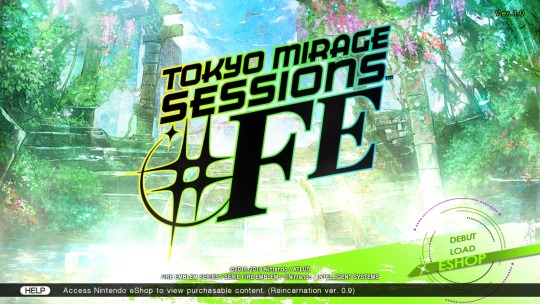
I’ll be talking about:
Story
Setting/Theme
Characters
Gameplay
1. Story
The story is nothing special - I enjoyed it, but it's a fairly typical jrpg "power of friendship and bonds" deal that is only made unique in any capacity by the idol culture that frames it. It's not bad, but it's not groundbreaking either. I wish the story were a bit longer to give more of a build up into the final confrontation. The earlier stages slowly start to set things up but even just one more dedicated chapter to ease into the final arc would have probably made the ending feel less rushed. That and I just enjoyed playing it overall and would liked more content.
The distinct chapters format to the flow may have been meant to simulate FE chapters while still also representing how persona stories often have noticeable breaks between dungeon arcs. In TMS though, it felt a bit more artificial, not damningly so, but I think the plot momentum was a bit worse for it.
The set up for each chapter break also revolves around Itsuki himself improving as an entertainer, even though he doesn’t know what direction he wants to focus on, and while it’s most emphasized early on, this aspect of Itsuki’s development himself feels almost abandoned or ignored through the mid and late game until the very end. The solution does make some sense, but some of the details that enable it to happen are a bit questionably contrived, and like the overall story, it felt a bit rushed in the final hour, based on what I remember.
Otherwise, the story did a good job of setting itself up, providing the characters with adequate motivation and means to seek the goals they set and each dungeon gave reasonable purpose for the main characters to tackle it.
The final chapter seemed to be trying to make up for the lack of build up by twisting and turning a bit more than usual, but most of its attempted twists were fairly standard fair for trying to draw out suspense and unfortunately were somewhat predictable for it. I was a little surprised at the host for the big bad, but mostly because I hadn’t been paying close enough attention so that was on me.
2. Setting/Theme

The Tokyo idol scene setting is the most interesting aspect of the story and while I can see it being polarizing, I found it novel myself. Mechanically, it does a good job of unifying the dungeons under a common theme of "things idols do" - such as posing for photo shoots or acting on TV.



Beyond dungeon design, the idol theme also naturally informed character designs and the multitude of costumes that appear throughout.
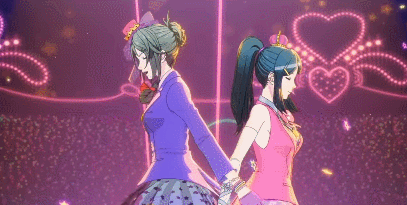
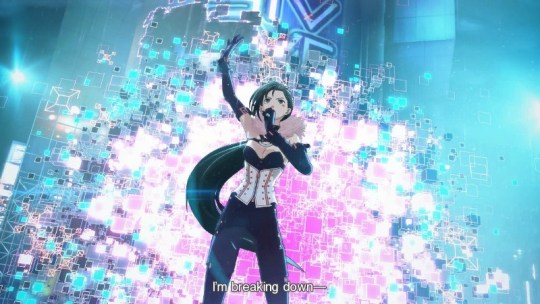

You can even see this thematic flair in the way that spell casting involves a character signing their autograph as a glyph!

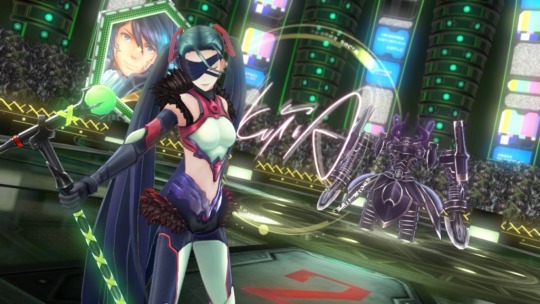
If there’s one oddity that stands out to me about the aesthetics of the game, it’s that the monster designs seem to be unable to decide whether they should be FE inspired or SMT inspired or neither, but even in the latter case most don’t seem to fit in with the idol theme in any capacity.
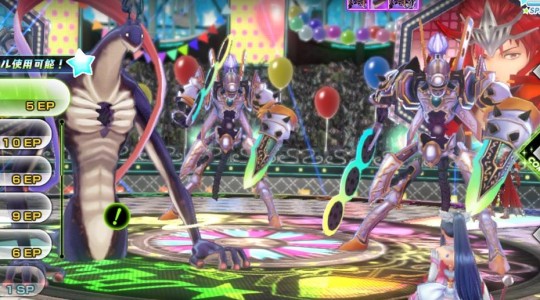
Even when enemies are FE inspired, they seem to have gone through a similar (if not more extreme) filter that the Mirage characters went through - becoming dramatically stylized and the only real purpose I can conceive for it is to make enemy classes that were definitely human in FE appear non-human here. For instance, the middle and right monsters above are myrmidon class enemies - unpromoted swordmasters from the FE universe.
Not to mention: Why do their out-of-combat sprites look like Organization XIII members!?

3. Characters

Like the story, the characters are good if nothing particularly revolutionary. Most seem built around one or two tropes but then are fleshed out beyond that which is fine. You learn more about them as you do their individual side quests (social links) and these do a good job of giving the feeling of evolving your bond with that character. The pacing of the side stories is mostly okay, though the gameplay reward for those that are plot locked to be very late doesn't always feel equal to how long you had to wait to do them. There's a bit of persona syndrome wherein all the chars get plenty of opportunities to interact with the MC, but would benefit from more time interacting with each other as well.
I liked all the characters in the end. There's a good variety between both the girls and boys, though because of join times some chars got more focused screen time than others. Again, I think a longer late game with more story side quests (instead of fetch quests) would have helped balance things out.
If I had to be as base as to rank the girls in terms of waifu ratings:
1. Eleonora
2. Tsubasa
3. Kiria
4. Maiko
5. Mamori = Tiki
Though it's worth noting that top four are all really close, and each slot only wins out over their competition by a small margin. I don’t dislike Mamori or Tiki, I just am not into the little sister appeal.

I suppose Barry Goodman is worth mentioning as well. Barry is a foreigner who settled in Japan and behaviorally embodies the most cringe-worthy aspects of otaku culture. He’s heavy-set, roughly groomed, and somewhat aggressive/abrasive about his passions. I’m not one to judge him for the subject of his passions, but the way he interacts with them would make me uncomfortable around him had he been a real person. Ultimately he is a good person at heart, but his poor people skills are unlikely to endear him to anyone on first impressions, and the fact that he doesn’t care only exacerbates his problems.
Finally, and predictably most disappointingly, the FE chars (heroes and villains) are barely developed and could be replaced with persona or persona like motifs without changing the overall plot. The FE aspect is little more than a coat of paint that gives secondary theme to the invading 'otherworld,' and it's a real shame and waste of potential.
Aside from the Mirage characters and Tiki themselves, there are however a few unmarked references that are at least self aware enough to be welcome Easter eggs for fire emblem fans:

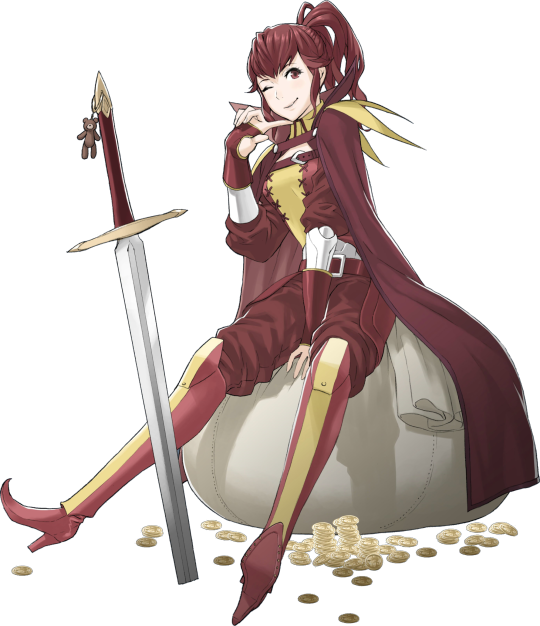
Anna is your convenience store shopkeeper, and there’s even a ‘shadow anna’ who will sell you more dubious dungeon consumables that a normal convenience store wouldn’t stock.


Ilyana works at the cafe, keeping close to her beloved food.
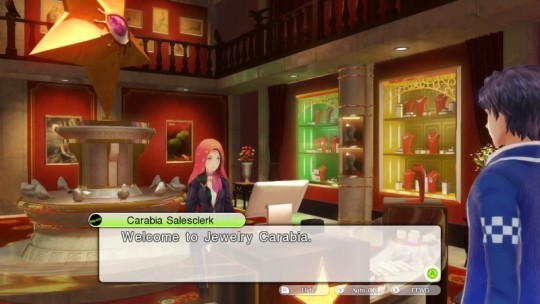
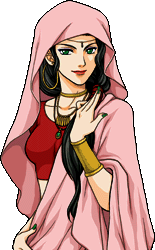
Aimee runs the jewelry store as she was the item store merchant in FE9 and 10
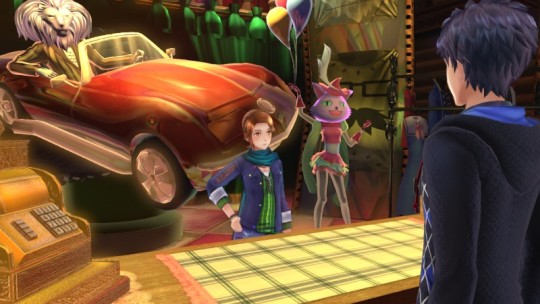

And Cath runs the costume shop. She’s a thief in FE6 with a distinct affinity for money, not unlike Anna, though not as extreme either. Admittedly, it’s been a while since I’ve read over her supports though.
I saw an npc employee at one of the random background shops in Shibuya central street that could also be Brady from FE Awakening, but the camera never got close enough to see him clearly enough to make a positive ID.
Finally, I found it amusing that all the playable chars' names are class puns/references
蒼井樹 = Aoi Itsuki > Aoi means blue in reference to FE lords typically having blue hair
織部つばさ = Oribe Tsubasa > Tsubasa in reference to her peg knight class
赤城斗馬 = Akagi Touma > 赤 (Aka) gives us “red” while 馬(uma) is “horse.” Red cavalier (partnered with a green cavalier) is a reoccurring archetype in FE. The Red cav tends to be the hot-headed one.
I can break down the others if desired, but these will do for examples.
4. Gameplay
Going to break this into a few parts:
General
Combat
Dungeons

1. General
The real reason this game is compared to Persona; gameplay mirrors a lot of persona's elements and it's almost easier to describe how it deviates from the Persona format than spend time detailing how they're the same. That said, if you like the persona formula (as I do), you'd probably enjoy TMS's gameplay flow as well.
While the lack of daily life and day limits for dungeons removes a lot of the tension of time management for them, I think it's fine since a lot of persona players rush dungeons in 1-2 days anyway and in TMS, once the dungeon is done, you don't have to worry about doing busy work to tick off the days until the plot is allowed to move forward again. The lack of social stats is an element of depth removed, but without a time cost element to activities, it makes sense and is probably a good thing for it to be absent from TMS (even if story wise it could have actually be viable as Aoi and the others grow their skills as performers).
Using the WiiU game pad as a smartphone screen to facilitate off-screen character interactions as well as display more detailed enemy information was clever if perhaps unnecessary (as persona 5 showed). Having the only map on the game pad actually made it a little disorienting to reference for me since my eyes had to leave my tv entirely, leading to me either holding my game pad up or bobbing my head up and down to compare my map with my surroundings. On the DS, the two screens are at least close by. I’d like to say there may have been a better use for the game pad, I’m not thinking of anything off the top of my head, so it may have been wise to minimize its use as a gimmick anyway.


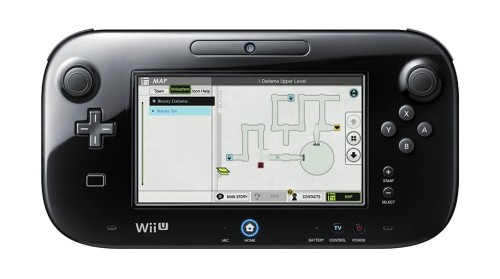
This is already in your phone history when you start the game, but it’s still probably my favorite moment from the text message logs:

#relatable.
Replacing persona fusion is a more straightforward crafting system that is the source for your weapons and passive skills, and in turn, much like Tales of Vesperia, your weapons are the source of your skills, both active and passive. The system sounds more grindy than it is in practice though. Simply advancing through the dungeons and fighting 70-80% of the monsters you encounter naturally will provide you with enough materials to forge most weapons as they become available. In fact there were a number of times when I ran out of new weapons to forge and had to push on with already mastered weapons equipped. I liked that bosses and some savage encounters would drop mats of a higher tier than what was readily available from current monsters, and you had to spend them wisely before advancing the plot to the point where those mats became common. It let you preview the next tier of weapons and abilities for select characters but who you gave those weapons to was never overly stressful since you could get the other weapons you passed on later anyway.
Rare monsters drop unique mats that can make weapons that give unusual or otherwise off-type skills to characters and it makes catching rare monsters that flee rather than engage the player rewarding. IIRC, I encountered fewer than ten rare monsters in my entire play through though, so I did not feel it worth the time to actively hunt them unless there was some trick to make them appear more reliably (and catching them was also a bit dependent on the surroundings). Like treasure monsters in P5, they usually had some kind of gimmick where they were only weak to one thing if they had any weakness and the latter ones also came with dodge [weakness] passive and had a chance of just up and running from battle.
2. Combat
The one-more mechanic is replaced by "Sessions" which are not unlike self contained one-more combos anyway. The tag in attacking animations were pretty fun and though late game sessions can get quite long, there’s no way to speed up or skip session animations, possibly in part because of the existence of duo arts which use the session animations as a timer. They could have prohibited skipping prior to deciding on a duo art and then allow skipping or speed up after, though. Long session animations didn’t bother me, personally though, as session attack animations were varied and interesting enough that I never got tired of even the early basic ones (most of which were replaced by late game).

Openly displayed turn order, plus some late game skills that can actually influence turn order were both welcome features as well.

Beyond sessions, specials, duo arts, and ad-lib performances were great at providing extra variety and changing the pace of what might otherwise be rote combat. While duo arts and ad-lib performances were rng bonuses that you mostly just take whatever you can get and be grateful, specials were more deliberate, needing a resource that builds slowly at first. Later on, with longer sessions and meter boosting passives, the sp gauge builds up much faster, but even then specials usually should be selected carefully, especially within boss battles where recovering lost sp is a bit trickier.
That said, special skills were not created equal. Even though buffs and debuffs are powerful, some of the later buffing and debuffing specials came late, at a point where I already had normal skills that could buff or debuff at almost if not the same potency without spending SP. Similarly, as my repertoire of skills grew, my ability to hit weaknesses improved and using specials to break through resistances became less necessary, even as monsters began appearing with more resistances.
Finally, Itsuki’s second special - “Strike A Pose,” was absurdly good and only got better as my session combos grew longer late game. The ability to give everyone twice the actions in a turn opens up so many other combos that often times, there was little reason to use offensive specials in favor of either two individual sessions or a concentrate/charge boosted session.
Inversely, I found myself using healing specials a lot less, and perhaps it was because I used Tsubasa a lot less late game - I made Chrom a great lord which gave Itsuki healing and support which was kinda Tsubasa’s niche previously, so with Touma able to out damage Tsubasa and Elly covering flying enemies, Tsubasa just wasn’t out in combat all that often, which meant Mamori was the only one with healing specials (which were helpful on occasion) but in the end using Strike A Pose allowed me to get normal heals out in extra abundance while still enabling attackers to make a play to help clear troublesome enemies.
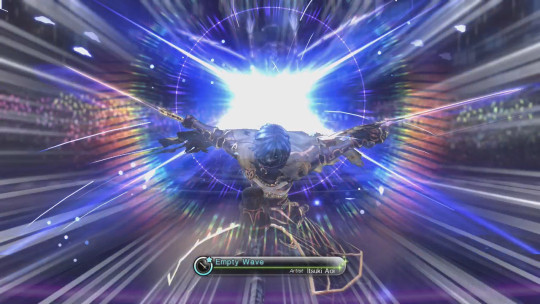
The FE weapon triangle’s representation in strengths and weaknesses among weapon types (not extending to magic though) gave a welcome way to predict weaknesses for enemies I had not encountered yet. One of the frustrating things about persona had always been that weakness/strength attributes for new monsters were difficult to predict and late game could cause you to walk into a bad situation that was never really your fault. Not only did the weapon triangle help mitigate some of the arbitrary mystery, but weaknesses were frequently consistent across similar enemy types at different levels even outside of the sword/lance/axe trinity. For example mage type enemies were, with few exceptions, all weak to swords and fire. Skills that deal effective damage (i.e. horseslayer/armorslayer) were also a great addition that gave characters tools to start session combos on enemies that they might otherwise be powerless against. The player also gets other ways to work around pesky resistances, features that are both welcome and necessary because...
If I have one glaring critic of the battle system it’s that Itsuki, like persona protags is mandatory. However, unlike persona protags, Itsuki has static combat tools and extremely limited ability to influence his own strength and weakness attributes. He’s always weak to fire and lances and since you can’t remove him from the front line, you always have someone in combat weak to those elements. Fortunately this is less deal breaking for the fact that Itsuki dying in combat doesn’t immediately game over (hallelujah!). In addition, later in the game most chars get passive skills that greatly increase their avoid against elements they’re weak to, Itsuki included. Still, being able to remove Itsuki from the front line would greatly increase your party diversity and flexibility. For a while after recruiting a second sword character, I had difficulty justifying putting him in the active party because Itsuki already filled the sword role. Eventually, I promoted Itsuki to a more support role and let the other char handle offensive sword plays.
One more minor complaint I have is the inability to swap out fallen allies. Having only three party members means that even one of them dying can be crippling, especially later on and on harder difficulties. I’ve wasted turns reviving downed allies and trying to heal back only for enemies to just repeat what killed someone in the first place and put me exactly where I was last turn with less healing items or sometimes in an even worse situation. While the boss dichotomy of easy/impossible with little in between that some persona bosses suffer from is present here, the existence of specials, ad-lib performances and duo performances that heal or revive greatly alleviate some of the comeback struggle that has a tendency to snowball in this combat system. As the only active non-rng option, specials in particular are important to the system. The severity of boss gimmicks isn’t quite as punishing in TMS compared to persona, but TMS’s smaller party size, can still cause a bad situation to cascade into unsalvageable territory.
3. Dungeons
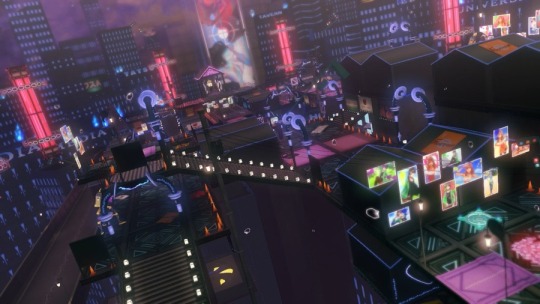
The dungeon design of TMS is interesting in that it departs from persona 3/4′s formula of randomly generated floors in favor of deliberately organized floor plans with usually only one correct path to the end. The linearity is sometimes broken up by treasures that you’ll have to backtrack for, but aside from that, there’s little mandatory backtracking within a dungeon. Dungeons stick around even after you clear them, allowing side stories to ask you to venture back over familiar ground for one task or another.
That said, the linear nature isn’t necessarily a bad thing. In TMS’s case, it allows the developers to give the player a learning curve for the dungeon’s mechanics and then challenge how well the player understood the earlier lessons, because the devs can guarantee that the player experienced the earlier sections before the later ones. It may sound obvious on paper, but it means that the developers can have a better awareness of the player’s competency at any given point in any dungeon, which is something that can’t be tracked when the player can go multiple routes at any given time. But I digress.
Another mechanical difference of note is how the player, Itsuki interacts with enemies pre-battle. In persona 3 and later, you could swing your weapon to hit an enemy in the field and that would start combat (at an advantage if they didn’t notice you), but in TMS, striking an opponent on the field knocks them back and stuns them, giving you the choice to then get closer and touch them to begin combat at an advantage or to avoid combat entirely. I like this greater degree of choice and it fits within the philosophy that TMS dungeons are made to be less stressful - less about meticulous resource management - than persona games. There’s still an incentive to engage in combat: you need to keep up a certain amount of level growth just to have the raw stats to beat bosses, but if you’re low on health and/or healing items or just plain short on available play time and you think or know there’s a checkpoint up ahead so you just want to make a push to reach it, you aren’t forced into battles you don’t want to engage in... with the exception of “Savage Encounters,” which are challenge monsters that seem to just exist to screw with you anyway. I think there was only one area prior to the last or second to last dungeons that had savage enemies I could actually beat albeit with great effort.
Playing TMS after Persona 5, it was also apparent that TMS’s idolaspheres were prototype palaces, from the set floor layouts and linear progression to the overarching themes of the dungeon informing its aesthetic and unique mechanics. In fact there are a number of things that TMS pinoeered for Atlus that then went on to feature in P5. You can read about some others here.
Puzzles were almost entirely navigation in nature - that is, how to use the dungeon mechanics and infrastructure to get from your start to your goal. It may be because it’s been a little over a month now, but none particularly stand out in my memory as being exceptionally good, while one or two I remember for being somewhat arduous or tiring. I’m still of the opinion that areas that the player is trying to solve puzzles in should have lower if not 0 encounter rate with random enemies, as battles, especially turn based ones that don’t tend to resolve in a single turn, can disrupt problem solving trains of thought.
Overall the dungeons are good though, and that’s important as they’re the meat of the gameplay. They are generally well paced with plenty to do and some minor stuff to find on your way to your target goal. Each dungeon’s unique mechanics fit with the dungeon theme and aside from a few exceptions the enemies are fairly distributed.
5. Conclusion
It has its flaws but I think, in the end, Tokyo Mirage Sessions #FE gets more right than it gets wrong. Even though the story was standard fair for this genre, I thoroughly enjoyed it and wished it had more content to its core for me to experience. I know there’s dlc, but the nature of dlc means that it’s nothing integral to the story and I’m not sure it would scratch the itch the way I want.
The setting is unique and the game fully embraces the themes it sets up and the themes in turn inform and affect almost every aspect of the game, giving it a unified appeal.
The combat is arguably more interesting than persona. It takes the same core formula of targeting weak points for massive damage but allows players more tools and freedom to circumvent bad matchups, make carefully planned strategic plays, or simply style on enemies with flashy satisfying attacks.
2 notes
·
View notes